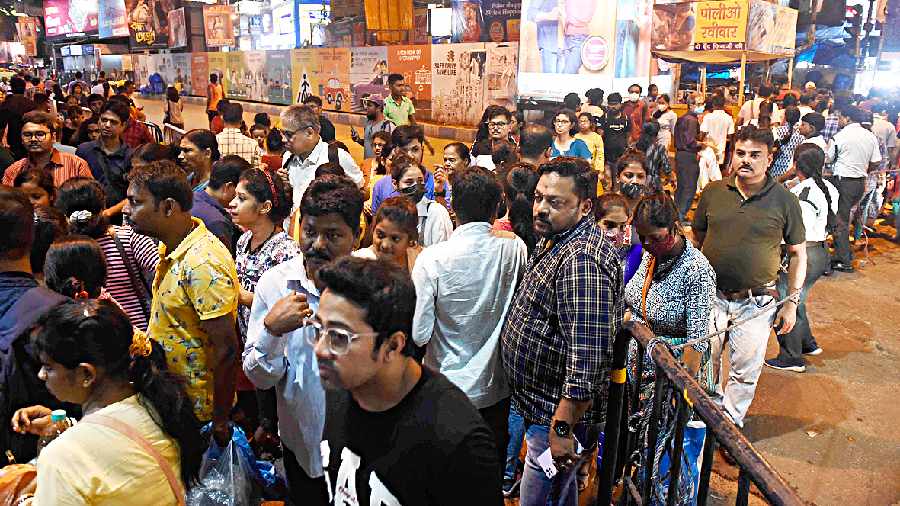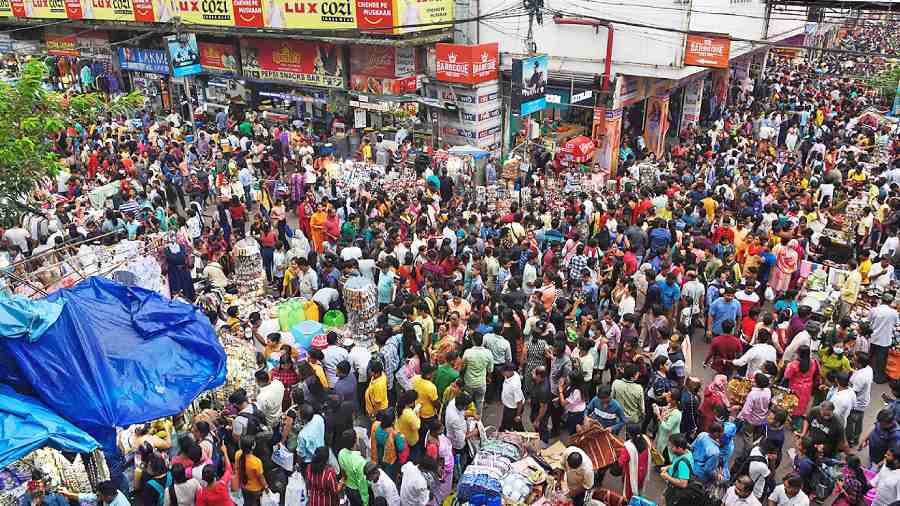The bazaars might be brimming over with people but the pre-Puja business is nowhere near the pre-pandemic levels, say traders across the city.
Even in the festive season, the demon of inflation cannot be slayed. For one set of shoppers, the puja purse has shrunk from 2018 or 2019.
For many others, the purse this year is marginally fatter. But that is far too little to offset the steep rate of the escalation of the cost of almost everything.
The result — reducing volumes and margins for traders. Less than two weeks to Bengal’s biggest festival, space might be hard to find in Gariahat and New Market.
But traders would say that a harder find was profit. The Telegraph presents the accounts of two traders and one shopper from among many this newspaper spoke to over several days about how they are battling price asura.
Gariahat
Balaram Saha, a hawker selling bedsheets and cushion covers at Gariahat for 26 years, is struggling to manage rising input costs and diminishing returns.
“Crowd does not mean business,” Saha told The Telegraph bluntly.
“Even that crowd can be seen only on weekends. Earlier, Durga Puja meant solid business for one month. The last two weeks would be a mad rush. But now, the weekdays have a lull even when Puja is barely two weeks away,” Saha said on Thursday.
His stall had a couple of women checking out various items. Two men were attending to them.
The purchase volume has gone down, said Saha.
A woman from Lake Market, a “loyal customer”, buys a set of bed and cushion covers almost every year, said Saha.
Only 2020 was an exception. But before the pandemic, she would buy stuff for her house as well as for her daughter, niece and nephew (all married).
This year, she bought one set for herself and another for her daughter.
Saha has a couple of employees in his store. Their salary and other expenses run up to almost Rs 2,000 per day. That includes trips to the wholesale market in Burrabazar.
Three years ago, I bought a bedsheet at Rs 200 and sold it at Rs 300. In 2022, a customer is unwilling to pay more than Rs 350 for the same thing. But I have to purchase it at Rs 280 now,” said Saha.
In 2019, Saha would sell stuff worth Rs 20,000-25,000 on a weekday when Puja was knocking on the doors.
This year, the number has been around Rs 15,000 on a weekday. On Saturday and Sunday, the sale would often go past Rs 60,000. Last Saturday, he sold stuff worth Rs 35,000.
New Market
Arsalan Shams, the owner of a menswear store in Shreeram Arcade, said his business was “at least 30 per cent” down from 2019.
The number of shoppers has also gone down, he said.
“People from Asansol and Durgapur would visit my store ahead of Puja before the pandemic. But now they are not willing to spend extra money on travelling,” said Shams

A crowded Gariahat market on Saturday evening. Picture by Sanat Kr Sinha
Shams has to spend Rs 15,000 a month for “maintenance”, excluding the salary of three men who work at the store. But the steepest rise has been in his wholesale buying rate.
A full-sleeve shirt, which would come at Rs 550 in 2019, costs him Rs 700 now. Shams sold the shirt at Rs 750 three years ago. Now, he is struggling to sell the same at Rs 850.
“There is a huge gap between the rise in the purchasing power of customers and the rise in the price of garments. The money that would get three pairs of denim before the pandemic is getting two now,” said Shams.
Buyer Biswajit Paul, a sales executive with a real estate brokerage company, earns more than what he did in 2019. His puja expenditure has gone up but the shopping volume has not.
Three years ago, he was a delivery partner with a food aggregator, covering Behala, Thakurpukur and New Alipore. Even after spending on fuel, he would take home around Rs 26,000 every month.
Petrol came at around Rs 75 per litre three years ago. Now, it costs over Rs 100 a litre.
“In 2019, I had a Puja shopping budget of Rs 5,000. But it covered something for each member of my family,” said Paul, who lives in Behala with his wife and parents.
This year, the same purchase cost him over Rs 6,000. A pair of denim pants, which used to come at Rs 800, now costs Rs 1,100, he said.
The last two years had been “exceptionally tough” and Puja shopping had taken a backseat.
Paul left the food aggregator in January this year, because “too many people” joined the profession after the pandemic. With limited resources, the “scope of income” was much better before the pandemic, said Paul, who joined the aggregator in 2018.
A graduate in political science, Paul also has done a hardware networking certificate course from a private institute. He earns around Rs 30,000 now.
But he is the sole earning member of the family and the rising cost of everything — from edible oil to LPG cylinders — has left him with virtually no surplus income.
